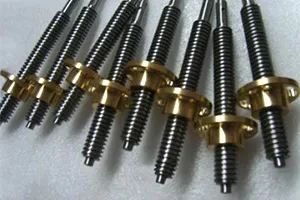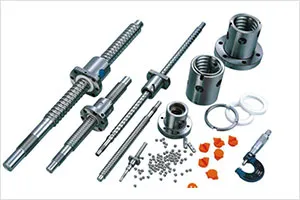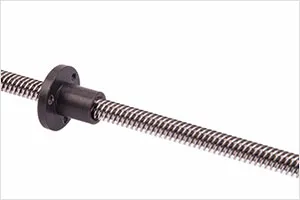Screw and Nut about Linear Step Motors
Basic stepper motors revolve by means of a magnetic rotor core that interacts with the pulsating electromagnetic field generated by the stator. Linear motors convert rotary motion into linear motion by combining a screw and a nut. Power screws are often perceived as being simple to operate, but making them appear easy is the result of thorough mechanical analysis and design, along with the appropriate selection of the proper components. 
 The ball screw assembly is typically made of carbon steel or stainless steel, with a recirculating ball bearing that rolls along helical grooves in the screw and nut. Thus, the nut can move along the screw without encountering sliding friction. Typically, sliding contact assemblies use nuts that are internally lubricated or made from bearing-grade bronze. Plastic nuts are generally mounted on stainless steel screws, while bronze nuts are mounted on carbon steel screws; stainless steel screws can also be used if the nut is a medium-grade bronze.
The ball screw assembly is typically made of carbon steel or stainless steel, with a recirculating ball bearing that rolls along helical grooves in the screw and nut. Thus, the nut can move along the screw without encountering sliding friction. Typically, sliding contact assemblies use nuts that are internally lubricated or made from bearing-grade bronze. Plastic nuts are generally mounted on stainless steel screws, while bronze nuts are mounted on carbon steel screws; stainless steel screws can also be used if the nut is a medium-grade bronze. 
Classification of screw
There are two main types of power screws: ball screws, which operate on rolling contact, and lead screws, which operate on sliding contact.
 The ball screw assembly is typically made of carbon steel or stainless steel, with a recirculating ball bearing that rolls along helical grooves in the screw and nut. Thus, the nut can move along the screw without encountering sliding friction. Typically, sliding contact assemblies use nuts that are internally lubricated or made from bearing-grade bronze. Plastic nuts are generally mounted on stainless steel screws, while bronze nuts are mounted on carbon steel screws; stainless steel screws can also be used if the nut is a medium-grade bronze.
The ball screw assembly is typically made of carbon steel or stainless steel, with a recirculating ball bearing that rolls along helical grooves in the screw and nut. Thus, the nut can move along the screw without encountering sliding friction. Typically, sliding contact assemblies use nuts that are internally lubricated or made from bearing-grade bronze. Plastic nuts are generally mounted on stainless steel screws, while bronze nuts are mounted on carbon steel screws; stainless steel screws can also be used if the nut is a medium-grade bronze. 
